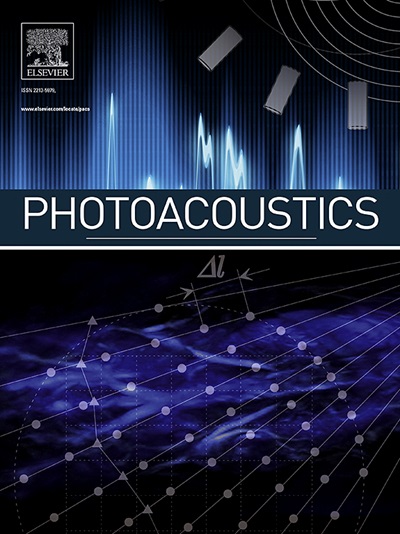基于结构先验的光声成像伪影去除迭代优化算法
IF 7.1
1区 医学
Q1 ENGINEERING, BIOMEDICAL
引用次数: 0
摘要
在现实中,光声成像(PAI)通常会受到稀疏阵列或有限视野所引起的伪影的影响。在这项工作中,为了平衡计算成本和伪像去除性能,我们提出了一种不需要对每个迭代周期重复求解正演模型的迭代优化方法,称为具有结构先验的正则化迭代方法(RISP)。结构先验是通过随机选择部分数组元素从多个重构图像中得到的概率矩阵。高概率值表明在这些位置的多个重建结果具有高的一致性,表明高概率代表真实的成像结果。相反,低概率值表示更高的随机性,更倾向于人工制品或噪声。作为一个结构先验,该概率矩阵与使用所有数组元素的原始PAI结果一起指导PAI结果的正则化迭代。仿真和真实的动物和人类PAI研究结果表明,我们的方法可以大大减少图像伪影,以及噪声。本文章由计算机程序翻译,如有差异,请以英文原文为准。
Iterative optimization algorithm with structural prior for artifacts removal of photoacoustic imaging
In reality, photoacoustic imaging (PAI) is generally influenced by artifacts caused by sparse array or limited view. In this work, to balance the computing cost and artifact removal performance, we propose an iterative optimization method that does not need to repeat solving forward model for every iteration circle, called the regularized iteration method with structural prior (RISP). The structural prior is a probability matrix derived from multiple reconstructed images via randomly selecting partial array elements. High-probability values indicate high coherency among multiple reconstruction results at those positions, suggesting a high likelihood of representing true imaging results. In contrast, low-probability values indicate higher randomness, leaning more towards artifacts or noise. As a structural prior, this probability matrix, together with the original PAI result using all array elements, guides the regularized iteration of the PAI results. The simulation and real animal and human PAI study results demonstrated our method can substantially reduce image artifacts, as well as noise.
求助全文
通过发布文献求助,成功后即可免费获取论文全文。
去求助
来源期刊

Photoacoustics
Physics and Astronomy-Atomic and Molecular Physics, and Optics
CiteScore
11.40
自引率
16.50%
发文量
96
审稿时长
53 days
期刊介绍:
The open access Photoacoustics journal (PACS) aims to publish original research and review contributions in the field of photoacoustics-optoacoustics-thermoacoustics. This field utilizes acoustical and ultrasonic phenomena excited by electromagnetic radiation for the detection, visualization, and characterization of various materials and biological tissues, including living organisms.
Recent advancements in laser technologies, ultrasound detection approaches, inverse theory, and fast reconstruction algorithms have greatly supported the rapid progress in this field. The unique contrast provided by molecular absorption in photoacoustic-optoacoustic-thermoacoustic methods has allowed for addressing unmet biological and medical needs such as pre-clinical research, clinical imaging of vasculature, tissue and disease physiology, drug efficacy, surgery guidance, and therapy monitoring.
Applications of this field encompass a wide range of medical imaging and sensing applications, including cancer, vascular diseases, brain neurophysiology, ophthalmology, and diabetes. Moreover, photoacoustics-optoacoustics-thermoacoustics is a multidisciplinary field, with contributions from chemistry and nanotechnology, where novel materials such as biodegradable nanoparticles, organic dyes, targeted agents, theranostic probes, and genetically expressed markers are being actively developed.
These advanced materials have significantly improved the signal-to-noise ratio and tissue contrast in photoacoustic methods.
 求助内容:
求助内容: 应助结果提醒方式:
应助结果提醒方式:


